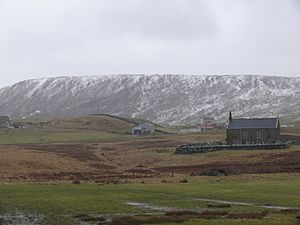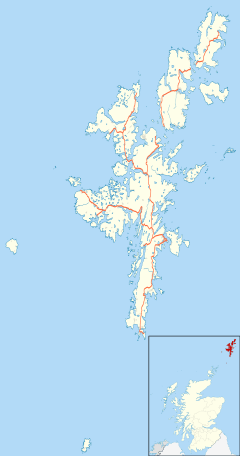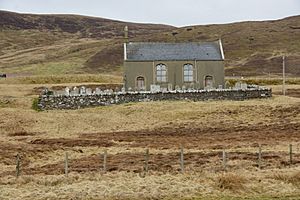Quarff facts for kids
Quick facts for kids Quarff |
|
|---|---|
 View of Easter Quarff and Quarff church, with Scrae Field in the distance (March 2010) |
|
| Population | 100 |
| OS grid reference | HU424356 |
| Civil parish | |
| Council area | |
| Lieutenancy area | |
| Country | Scotland |
| Sovereign state | United Kingdom |
| Post town | SHETLAND |
| Postcode district | ZE |
| Dialling code | 01950 |
| Police | Northern |
| Fire | Highlands and Islands |
| Ambulance | Scottish |
| EU Parliament | Scotland |
| UK Parliament |
|
| Scottish Parliament |
|
Quarff is a small village found on Mainland in the Shetland Islands of Scotland. It's about 5 miles (8 km) south of Lerwick, the only town in Shetland. The village is built along a valley that was carved out by glaciers long ago. This valley runs from east to west, with tall hills on both sides.
Quarff has two main parts:
- Easter Quarff is closer to the main road and the east coast.
- Wester Quarff is about 1.5 miles (2.4 km) west and faces the Atlantic Ocean. A small road connects these two parts of the village.
Contents
Quarff's Past: A Look at History
The name "Quarff" comes from an old Norse word, "Hverfi." This word means "a bending shape," which fits because the hill to the north of the village has a bend in it.
For a long time, Quarff was an important place for moving goods. People could transport items and even boats across the island here. This helped them avoid a long sea journey of about 40 miles (64 km) around Sumburgh Head. In 1794, it was noted that people in Quarff often earned money by moving goods from one side of the island to the other.
In 1830, most villagers were sea fishermen. They caught fish like cod, ling, and herring. They also farmed small pieces of land, growing potatoes and corn.
There is also proof that people lived in this area during the Stone Age. Around 1900, a local farmer dug up a mound on his land. He found a stone slab covering a small stone room. Inside, there was a skull and a bowl. Other similar rooms have been found nearby.
How Many People Live in Quarff?
In recent years, the number of people living in Quarff has grown. About 25 years ago, Easter Quarff had 12 small farms (called crofts) and 28 houses. By 2004, there were over 70 homes! Wester Quarff, however, has stayed about the same size, with around 13 homes grouped together.
Village Life and Services
Quarff gets its water from the Sandy Loch reservoir in Lerwick. Currently, homes in Quarff do not have a main sewage system; each house uses its own septic tank.
Buses that travel between Sumburgh Airport and Lerwick pass through Easter Quarff regularly.
The village also has a community hall. This hall is used for many activities, like youth clubs and play groups. It's also a place for events during the folk festival and other gatherings.
Quarff Church: A Historic Building
The Quarff Government church and its minister's house (manse) were finished in Easter Quarff in 1830. The famous engineer Thomas Telford designed the church. It is located on a rising bank about 500 yards (457 m) from the sea.
The church is no longer used for regular services. Instead, services are held in the Old Manse on the Lerwick Road every Sunday. The churchyard, however, is still well looked after and used for burials.
Learning in Quarff: Schools and Education
Quarff Primary School used to teach local children aged 5 to 12. It opened in 1879 but was closed by the council in 2003. In 2001, the school won an award for an art project. This project involved all 12 pupils, their teacher, a local art gallery, and an artist.
| Year | 1971 | 1976 | 1981 | 1986 | 1991 | 1996 | 2001 | 2004 |
|---|---|---|---|---|---|---|---|---|
| Population | 17 | 19 | 23 | 21 | 15 | 10 | 12 | n/a |
The number of students at the school went down from 25 in 1987 to just 12 in 2001. This might have happened because parents working in Lerwick chose to send their children to schools there. When the teacher moved to Cunningsburgh School in 2003, Quarff Primary School closed. The students then moved to the school in Cunningsburgh, about 4 miles (6.4 km) south. School transport is available for them.
For older students, the closest secondary schools are in Sandwick or Lerwick.
Gallery
-
Easter Quarff and the oil rig GSF Arctic IV







